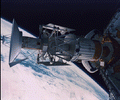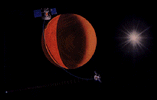


 Assembly
AssemblyOn May 4, 1989, the Magellan spacecraft was deployed from the shuttle. The spacecraft is topped by a 3.7m (12ft) -diameter dish-shaped antenna that was a spare part left over from the Voyager program. The long, white, horn-shaped antenna, attached just to the left of the dish antenna, is the altimeter antenna that gathers data concerning the surface height of features on Venus. Most of the spacecraft is wrapped in reflective white thermal blankets that protect its sensitive instruments from solar radiation.
 Deployment
DeploymentThe Magellan spacecraft's deployment from the shuttle Atlantis' cargo bay was captured by an astronaut with a hand-held camera pointed through the shuttle's aft flight deck windows. Deployment occurred in the early evening of May 4, 1989, after Atlantis had carried Magellan and its Inertial Upper Stage (IUS) booster rocket, into low Earth orbit. Once the shuttle was safely away from the spacecraft, the IUS ignited and placed Magellan on course for its 15-month journey to Venus.
 Next stop: Venus
Next stop: VenusMagellan gets a final boost from the second stage of the Inertial Upper Stage in this artist's depiction. This event occurred on May 4, 1989, and signified the beginning of the operational phase of the spacecraft. Magellan entered the orbit of Venus 15 months later on August 10, 1990.
 Orbiting Venus
Orbiting VenusOn August 10, 1990, Magellan entered into orbit about Venus, as depicted in this artist's view. During its 243-day primary mission, referred to as Cycle 1, the spacecraft mapped well over 80 percent of the planet with its high-resolution Synthetic Aperture Radar (SAR). By the end of the mission, 99% of the planet had been mapped. The spacecraft returned more digital imaging data in the first cycle than all previous U.S. planetary missions combined.
 Mapping Venus
Mapping VenusThe sequence of events that comprise a Magellan mapping orbit are shown in this artist's conception. For the first 37.2 minutes of each orbit, the Synthetic Aperture Radar measures and records a 20 km (12 mi) -wide swath of the planet's surface. When Magellan reaches the high point of its orbit, the spacecraft turns its antenna toward Earth and transmits the data. After 113.8 minutes of transmitting, the antenna is repositioned for another orbit about Venus. The spacecraft used this orbit to complete three mapping cycles of radar-imaging data and two cycles of gravity and radio science data. In May, 1993, the spacecraft entered its final, aerobraking phase, in which its orbit was gradually lowered and made more circular, allowing Magellan to collect more gravity data and to conduct radar and radio science experiments. The Magellan mission ended when the spacecraft was allowed to plunge into Venus' atmosphere in October, 1994.
